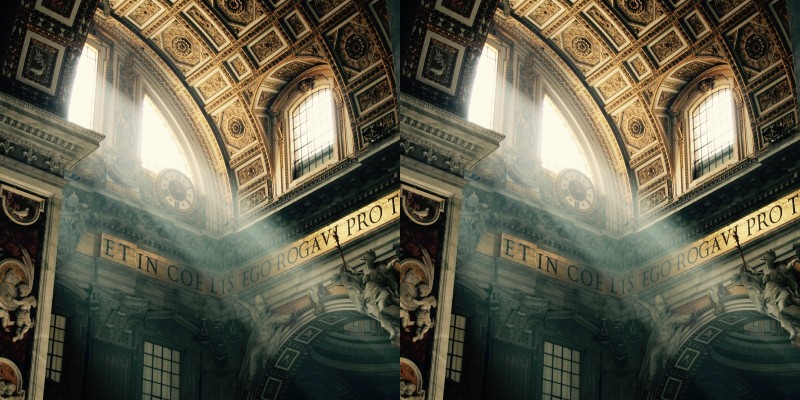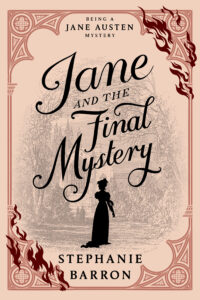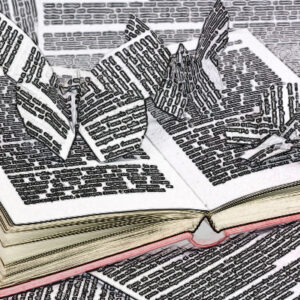Jane Austen died on July 18, 1817, at the ridiculously premature age of forty-one, in the ancient royal and ecclesiastic city of Winchester, where she had gone in a desperate attempt to treat and survive what medical historians suspect was either Addison’s Disease or pancreatic cancer. Number 8 College Street, the Winchester house where she lodged for more than six weeks that summer, has one of those blue plaques the British affix to buildings where The Great have lived and died. Austen is buried in Winchester Cathedral, making the southern Hampshire town a non-negotiable stop on every Janeite tour.
So when I started to map out the fifteenth and final novel in my detective series featuring Jane as an amateur sleuth, Jane and the Final Mystery (Soho Crime, Oct. 24, 2023), I knew I had to set the book in Winchester. Over the past thirty years of writing the series I had brought Jane to exactly this point: her famous deathbed. But I did not want to build an entire novel around a wasting patient stuck indoors as she dwindled; I’m too fond of Jane, and the setting had too much to offer. In addition to the ancient cathedral with its captivating Close—a walled green enclave of exclusive homes—it had Winchester College, the oldest boys’ public school in England, founded in the thirteenth century. And no fewer than eight of Jane’s nephews were Old Wykehamists, as Winchester College grads are called.
I realized I was writing, in essence, a boarding school mystery—replete with the coded culture, closed circles, rarified atmosphere and eccentric population of every academic cloister worth begging for admission. With this choice I followed a hallowed tradition—some of the most absorbing and bingeworthy of detective fiction is set in boarding schools, the very stones of the buildings and quirks of the landscape serving as additional characters in the novels. I could expound at length on the Harry Potter series, but with a sidelong glance at the most dominant boarding-school suspense/fantasy/escapist childhood series ever written, I’ll forbear.
Herewith, some of my favorites:
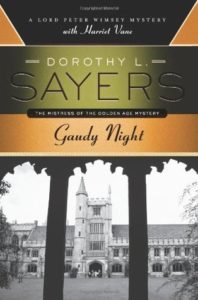
Gaudy Night, by Dorothy L. Sayers. The second-to-last of her Golden Age novels to feature Harriet Vane, and as consumed by romance as it is by jeopardy, this story set in an Oxford women’s college is, in my view, the Sayers book that separates the wheat from the chaff. There will always be fair-weather Sayers readers, who talk knowingly about The Nine Tailors or Murder Must Advertise as canon entries, and those who deplore Sayers’ late-Victorian cluelessness regarding diversity, equity, and inclusion. But for true DLS aficionados capable of looking beyond the author’s failings, Gaudy Night is the apotheosis of Peter Wimsey fandom. It’s where the Golden Boy comes clean, and offers up his heart and soul in a punt on the Isis; where the New Woman realizes she can have love and a Writing Career, too. Set against the dreaming spires of the university town, the revenge plot to destroy members of Harriet’s college—and Harriet herself—forces the protagonists to confront their past lives, professed ideals, and eternal loyalties. If you can read this after first absorbing Vera Brittain’s scarifying World War I memoir Testament of Youth (Brittain was a classmate of Sayers’ at Somerville College) and Mo Moulton’s Mutual Admiration Society, which details Sayers’ Somerville circle, you’ll be all the richer for the experience.
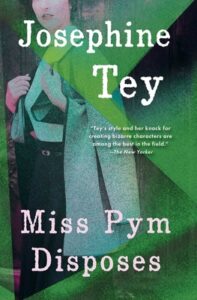
Miss Pym Disposes, by Josephine Tey. Another Great of the Golden Age, Tey is sometimes held up as the anti-Sayers, perhaps because Sayers allegedly disparaged her as a mediocre talent (“Her spiritual home, a boarding-house in Bournemouth.” One must be British to fully appreciate the put-down.) I suspect that if true, rather than apocryphal, the comment reveals Sayers’ envy as much as her disrespect. Tey, a pseudonym for the Scottish-born Elizabeth MacIntosh, was a respected playwright with London stage productions to her credit as well as mystery novels (The Daughter of Time, Brat Farrar) that are unquestionably part of the canon. In Miss Pym Disposes, she offers the counterpart to Gaudy Night. Miss Pym is an acute observer at a women’s academy for the training of physical education teachers—where the victim dies because of a poorly-adjusted vaulting apparatus. The focus on physical, rather than intellectual, achievement allows Tey to rope in characters from various social milieux: striving scholarship girls, the careless rich, and earnest intellectuals willing to die for their best friends. The story’s closure is one of the more poignant in detective fiction, involving clemency and sacrifice.

Tinker, Tailor, Soldier, Spy, by John le Carré. I will plant my flag on Jim Prideaux, temporary teacher, showing up at Thursgood’s School in a trailer in the rain, as the unifying arc of this foundational spy novel. Jim, like so many people who find a safe berth in an obscure academic corner where they can use their classical training to buy cover and time, has A Past. He also has An Agenda. Cast out of MI6’s Circus, Jim substitutes Thursgood’s School, with its feckless, yearning, and abandoned boys, for his clandestine company of good fellows. Le Carré knew in his most intimate bones the humiliations, rivalries, and brutalities of a British public school, and his kinship with all of it dictated his map of The Circus—the spookish adult world of betrayal where public school boyhood finds its end. Le Carré’s seminal work is also in some ways the seminal work of British schoolboy culture.

The Secret History, by Donna Tartt. I first read this novel when it was published in 1992, while I was not far distant from my own college days. The novel’s effect upon me when I reread it recently was mesmeric. Tartt’s prose is elegant and finely-wrought; not a single word or phrase feels unnecessary, false, or out of place. The slow unraveling of the obsessively-close group of five Classics students at a small New England college is suffused with aching nostalgia, for a paradisical type of friendship only possible in tandem with a purposefully blind innocence that, in this case, is shot through with betrayal, calculation, and corrosive jealousy. The novel seemed at its debut to be an instant classic, and its formal cadences and studied charms read now as something fixed in the last century, alien to this one. The clique’s murders—of a complete stranger and then of one of their own–are secondary, the romance of time, place, and enduring tragedy, everything.
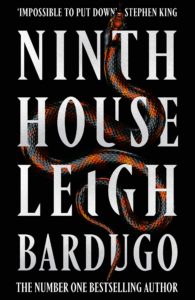
Ninth House, by Leigh Bardugo, and its sequel, Hell Bent, are about as far from Tartt’s Hampden College as it is possible to travel, signaling a fantasy world firmly with its feet in our darkening age. Bardugo’s Yale University is a supernatural campus dominated by its eight secret societies, and policed by a (fictional) ninth, Lethe House, whose students—exemplified by protagonist Alex Stern–are charged with stemming monstrous and spectral violence. One could dismiss this as a sort of Harry Potter series for grown-ups, but the clever rearticulation of Ivy League pretensions and tropes, as well as its pervasive dark humor, poignant humanity, and cast of stand-out sidekicks make it thoroughly adult entertainment at its best.
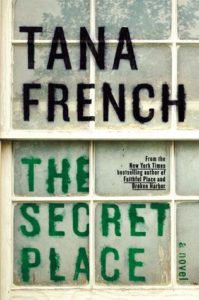
The Secret Place, by Tana French. An entrant in French’s Dublin Murder Squad series, this remarkable novel is perfectly possible to read as a standalone, as is true of all French’s work, a feat she deserves greater recognition for sustaining, book after series book. Four teenaged girls boarding at a Catholic high school form a spiritual pact under the moonlight in their favorite spot on campus, and unleash a chain of events that sunders their perfect friendship forever. That theme of a precious cloistered world—and of group solidarity unsustainable amidst the ugliness of a broader society—is essential to the academic mystery; violence in the form of murder upsets the balance of Arcadia, and only Justice can reverse the destructive power of evil. Laced with the humiliations of sexual harassment at the hands of doltish neighboring schoolboys, with the power of feminist resolve, and with the courage of personal sacrifice, French’s story is complex enough to leave the reader sorrowing for the waste of any number of lives; neither the charmed circle of schoolgirls nor their victim emerges free of taint.

The Lying Game, by Ruth Ware. Four girls tied by schoolgirl murder are also the center of this beautifully-written book, but with an important difference from French’s novel: these girls have grown up, and the violence in their pasts threatens the lives each of them has managed to live in its shadow. The discovery of human remains in the liminal ground between fields and marsh surrounding their old boarding school—a nostalgic place Ware allows us to experience through the girls’ eyes in this dual-timeline novel–causes one of them to summon the others to her home, a deteriorating mill formerly owned by her artist father/school instructor. Her friends rush to support her, ostensibly to attend their school reunion, but in truth to lay the unquiet ghosts of their conflicted pasts. Memory, with its mutable face, is perhaps the strongest character in this world half-sinking into water; it flickers and distorts, betrays and unites, and stridently demands the truth.
***

